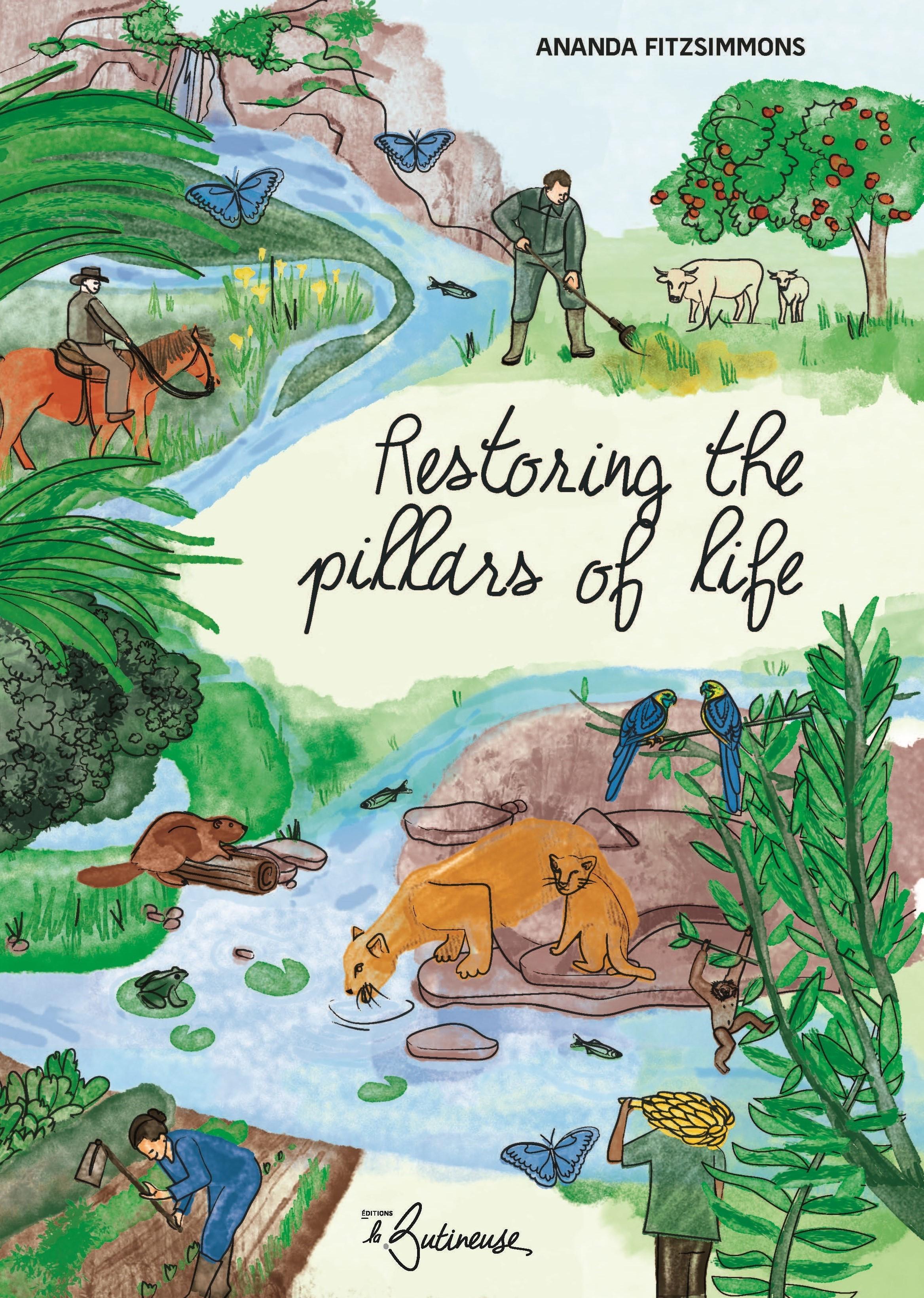

Restoring the Pillars of Life
Other titles available from Éditions La Butineuse:
Farmers have the Earth in Their Hands, Paul Luu
Land and Climate. Insights from the IPCC Special report, Patrick Love
Energy chronicles. Keys to understanding the importance of energy , Greg de Temmerman
Feeding the Earth. A Manifesto for Regenerative Agriculture, Daniel Baertschi
Farmers have the Earth in Their Hands, Paul Luu, with Marie-Christine Bidault
The Climate General, Tom Middendorp, with Antonie van Campen
Cover and interior design: © Agence Coam
All rights of reproduction, translation and adaptation, reserved for all countries.
ISBN: 978-2-493291-75-2
© 2021 Éditions La Butineuse
Atelier des Entreprises
Place de l’Europe – Porte Océane 3 56400 Auray – France www.editions-labutineuse.com
Ananda Fitzsimmons
Restoring the Pillars of Life
Introduction
Life on Earth is changing. Our climate is changing. We live in a time where the average temperature rises with each decade, a process of warming that is accelerating. According to the State of Global Climate report, published by the World Meteorological Organization, 2023 was the hottest year on record, with the global average near-surface temperature at 1.45° Celsius above the pre-industrial baseline. It was the warmest ten-year period on record. For the temperature to remain stable, a balance must be struck between the amount of heat from the Sun that is absorbed by the Earth’s surface and atmosphere and the amount reflected back into space. Clearly the Earth now retains more heat than it releases. We know that greenhouse gasses in the atmosphere trap heat. When we talk about climate change, most people think of the greenhouse effect.
But what if the problem is more complex? What if, in addition to trapping more heat in Earth’s atmosphere, we are also destroying the infrastructure that regulates temperature? Although burning less fossil fuel is absolutely critical, achieving reduction targets will take long and are not sufficient in themselves to avoid reaching irreversible tipping points. Our modern lifestyle has removed much of the natural infrastructure used to sustain the carbon and water cycles, two of the Earth’s most important climate regulating systems.
Not only is the Earth getting warmer, we are living in the time of the sixth mass extinction of life on the planet. The number of species of animals, plants and insects going extinct is accelerating. Since 1970, we have lost 70% of our species biodiversity. This biodiversity is a big part of the infrastructure which regulates climate. We are at fault when we talk about the climate crisis and the biodiversity crisis as if they were two separate crises. Healthy diverse ecosystems are key to regulating and restoring climate.
In Hydrate the Earth, I gave the example of John D Liu who documented a massive ecosystem restoration project on the Loess Plateau in China. In one area of the plateau, little more than a patch of barren desert, restoration was achieved without planting anything. Workers dug trenches in a grid pattern. Afterwards they piled bales of straw into the trenches. Then they waited for rain, and when in the desert it does rain, it usually rains heavily in a short time. The result was that microbes, which were dormant in the wet straw, began to create soil. They needed carbon and water to activate. They got to work decomposing the straw, releasing nutrients, which in turn activated other small creatures and dormant seeds. Vegetation began to grow, further breaking down the straw. This new vegetation acted as a seal, keeping water so that it didn’t evaporate. A cascade of life spread slowly through the desert. Every spurt of life attracted more life, more biodiversity. As the land became more hospitable, more plants grew, more birds and insects arrived in a widening and virtuous circle of life.
John D Liu’s story shows how carbon, water and biodiversity are the three pillars of life . But wherever modern industrial society establishes itself a systematic decline of carbon in the soil, a reduction in the quantity and quality of water resources and a steady decline in species biodiversity inevitably follows.
The purpose of this book is to show how these three pillars of life are interconnected, and understand the fundamental role they play in preserving life on our blue planet.
And see how we all can contribute to stopping a climate disaster and re-establish a flourishing life on Earth. Healthy natural ecosystems play a crucial role not only in creating resilience to the effects of climate change but they can actually help to mitigate it.
The IPCC clearly states that ecosystem restoration must go along side reducing our greenhouse gas footprint, yet not enough people are focused on this. When I believed that the only thing that could be done about climate change was reducing the use of fossil fuels, I felt only governments and big corporations could avert the climate crisis. I could cut my energy use or sign petitions, but I doubted the real impact of those decisions. When it became clear that other contributing factors were involved, I saw many more avenues for change. We are going to hear the stories of many inspiring people who found their path to making a difference by working with the pillars of life.
I hope they will empower you to find ways to be part of the solution. I have included some experiential learning exercises to help you understand the concepts concretely, not only as abstractions. They can be done in a school classroom, in any community-organised learning group, or just on your own.
Chapter One Life Cycles
Almost all energy on Earth comes from the Sun in the form of heat and light. Natural cycles distribute this energy, transform it and spread it around the world. Carbon and water are two of the primary drivers of the balance of heat on our planet as they change from gas to liquid to solid using the Sun’s energy.
Water is the primary buffer of our climate. Without water vapour and other greenhouse gases in the atmosphere, the Sun’s heat would quickly radiate back into space, leaving the Earth a cold barren place. Carbon, once sequestered in solid form, remains out of the atmosphere for a time. Each time carbon or water change phase using the Sun’s energy, they redistribute heat. When the carbon and water cycles are balanced, life on Earth thrives.
Carbon, water and biodiversity are the three pillars of life. The first two − carbon and water − are the main building blocks on which the third depends. If we want to continue to have a liveable planet, we have no choice but to understand better how these cycles work, how human activity has disrupted them, and how we can help to restore the balance.
Create your own mini water cycle in a bottle.
Find a large jar with a tightfitting lid. Cut out a piece of fine mesh screen to fit its diameter. Find a few medium sized stones to form the bottom layer. Then place the screen over the stones. Now find a place among some mosses and small low growing plants. With a small shovel dig up the soil at least to the root depth of the plants. Place a layer of soil (worms, bugs and all) over your screen. The screen keeps the soil from falling to the bottom of the jar. Then place some small plants, cover them with a bit of moss, but leave enough room above them so they can grow. Water your little garden and screw on the lid.
Place the jar in a location where there is Sun for at least part of the day and watch the water cycle in action.
You will never have to open the jar to water the plants. Water will settle to the bottom around the stones. The plants will absorb the water, then, through their leaves, release it into the air as water vapour (this process is called ’evapotranspiration’). You will see this vapour condense on the sides of the jar and run back down. Your little terrarium will keep on recycling its own water, carbon and oxygen without any help from you!

Closed Loop Systems: The Biosphere 2 Experiment
A sustainable system is a closed loop system. It feeds energy into itself to perpetuate continuous recycling over a long time. For example, dead vegetation becomes the food for the next generation of plants, helping them to grow. Ecosystems have evolved in such a way that species complement each other’s life cycle. A bird follows a herd of ruminant animals to feed off the insect larva which hatch in the manure of the grazers. The wastes of the two species fertilise the soil, which enables the grasses to grow lush. Grasses nourish the ruminants and the cycle repeats. Nothing is wasted. How different is this from modern society in which we generate mountains of waste, with less and less room to dispose of it?
In the early 90’s a gigantic research facility was constructed by a group in Oracle, Arizona. The group was influenced by Buckminster Fuller’s concept of Spaceship Earth, the notion that we are passengers on this planet, hurtling through space with only a limited number of resources. The group wanted to create a sustainable closed loop system. Their project was also motivated by the desire to find solutions to surviving a potential nuclear disaster and to establishing future colonies on other planets. The project was called Biosphere 2; Biosphere 1 was planet Earth.
Biosphere 2 was a closed facility which included areas designed as miniature versions of natural biomes: a rainforest, an ocean with a coral reef, a mangrove wetland, a savannah and a fog desert. The biomes were stocked with the insects, birds and fish normally present in such ecologies. Members of the community had living quarters, laboratories and workshops. They grew their own food and raised domestic animals, including pigmy goats, chickens, dwarf pigs and tilapia fish. They also treated their own waste material. Eight “biospherians” (as they called themselves) chose to live in this alternative world bubble for two years, attracting great interest and debate from the media.
The debate continues as to whether the experiment succeeded. Although they did not fully succeed in creating the perfectly balanced closed loop biosphere they hoped for, there was no accumulation of toxins within the facility, and the farm was among the world’s highest producing per surface area. All the biospherians were in excellent health when they came out.
Yet they did report being hungry much of the time and found living together not altogether easy. The biggest issue, which required outside intervention, was that oxygen levels gradually declined. After sixteen months they had fallen to such dangerously low levels that they showed symptoms of oxygen deprivation. After many months of trying to adjust the balance of carbon and oxygen in the biosphere, it was discovered that the cause was some exposed concrete in the structure, which was absorbing oxygen. Outside air needed to be pumped in. There were ecological imbalances as well. Pollinator species did not survive; there were outbreaks of invasive insects; the so-called natural biomes failed to maintain their ecological balance; condensation made the desert too wet; morning glories overtook the rainforest, blocking the light. The team struggled constantly to compensate these imbalances.
All of the urine and faeces generated, all of the water used in washing, all of the food waste and waste material from the animals had to be sanitised and recycled in a natural closed loop system that didn’t pollute. One of the biospherians, Mark Nelson, was in charge of waste water systems at Biosphere 2. He went on from his time there to create more similar systems all over the world, that he described in his book The Wastewater Gardener: Preserving the Planet One Flush at a Time. The whole experience was an education in understanding the biological complexities of the closed loop cycles of life in a way that modern society has painfully neglected.
It was, however, a profound learning experience for everyone involved. Imagine having to think about everything you use in your life, where it comes from, where it goes? What is involved in producing your food, your clothing, your house, your car, and what happens when you no longer have any use for it?
The Carbon Cycle
Carbon in its gas form is CO2: one molecule of carbon bound to two of oxygen. Carbon is severed from its two oxygen molecules through photosynthesis. Using the Sun’s energy, plants breathe in CO2 and breathe out oxygen. Only green plants – and phytoplankton - have this ability. It is a real “superpower”. Without it, carbon would remain in its gas form.
A plant draws water and minerals from the earth. Within it, carbon molecules join with water molecules (CH2O) to become a liquid. Into this special “carbon juice”, it blends its own unique set of molecules which contain its DNA. As the plant grows it creates more biomass. Biomass is the basic stuff of life.
Through its roots, the plant releases this carbon juice into the soil, which attracts microorganisms. This is a kind of currency which plants use as barter to get the other elements they need and can’t produce themselves. In exchange for some of its carbon, the plant receives nitrogen, phosphorus, potassium and other elements.
Plants are energy in solid form. Other creatures eat them in order to get the nutrients they need, which in turn helps them to grow and maintain their own biomass. So, the energy from the Sun that plants synthesize transforms it into the biomass of all living things.
Living things produce waste material, and they also inevitably die. Both their waste and their bodies are composed mainly of CH2O. When an animal dies, its body decomposes. In this process, water evaporates, microbes and insects break down the carbon and nutrients. Some of the carbon turns back into a gas through microbial respiration, binding with oxygen and released into the air. But some of it sinks into the soil and remains trapped as organic matter. It may lie deep in the earth where there is not enough oxygen for it to turn into a gas. This is the case with wetlands and peat bogs, where decaying organic matter is trapped under water.
Layers of organic matter build up, and the weight pressure keeps it down there for a very long time. This is how fossil fuels were created. Decayed biomass was trapped under pressure deep in the ground for hundreds and thousands of years. When we harvest fossil fuels and burn them, or when we dig up a wetland or a peat bog, we expose that biomass to oxygen, causing it to volatilise and return as CO2 to the atmosphere.
When we talk about “sequestering” carbon, we mean the amount of time carbon remains in a solid or liquid form in the earth, instead of combining with oxygen and returning to the atmosphere. Sometimes in our climate change conversations, we tend to think that we simply need to capture carbon and keep it out of the atmosphere. Technologies are being developed to store it in vaults in the earth. But carbon is part of the life cycle, taking it out of that cycle is only a partial and temporary solution. Maybe it will compensate for the speed in which we have harvested long term carbon storage such as fossil fuel, forests and bogs. But it will not restore the balance of life; only nature can do that.
Over the past hundred years, we have reduced the volume of biomass on the planet by 50%. Think of biomass as sequestered carbon; think of biomass as life. There should be more carbon stored in both living and dead things than is volatilised and returned to the atmosphere. Human activity has reduced the amount of living biomass, of which humans represent only 0.01%. According to Visual Capitalist, the entire volume of living biomass on Earth in 2020 was 1120 Gigatonnes, while the volume of anthropogenic mass, or man-made, non-organic material created between 1900 and 2020 was 1154 Gigatonnes.
We have reduced the volume of life on the planet and replaced it with stuff that will not decompose and re-enter the cycle of life. Along with sequestering carbon, we need to think about increasing the amount of life on the planet, the number of plants photosynthesising sunlight and living ecosystems storing carbon on the ground.
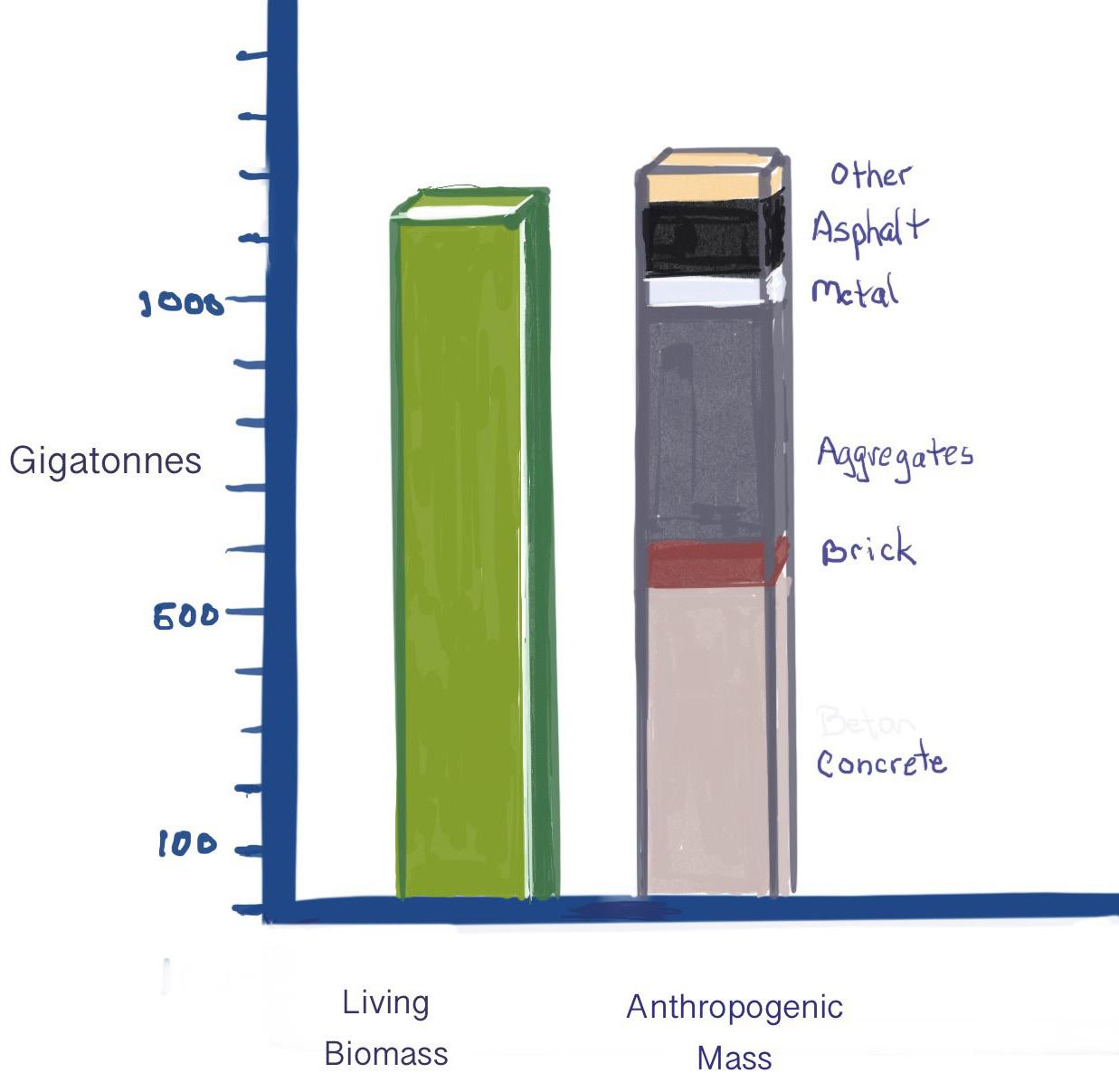
The Water Cycle
It is often said that water is life. Many indigenous cultures recognize the centrality of water and hold stewardship for the water as a core value in their cultural practices. Water combines with carbon to create CH2O, the basic building block of life. All living things need it. We can survive over a month without food but only a few days without water. When living things die, water leaves their body.
Like carbon, water uses solar energy to change phase. Unlike carbon, which uses light to power photosynthesis, water requires the heat of solar radiation to convert from liquid into vapour. The warmer the temperature, the more water evaporates. As water vapour, it carries heat energy as it expands and rises. The heat is no longer sensible heat, which can be felt, but latent heat,
which is stored but not expressed. The energy of the heat is carried in the water molecule. When the temperature cools, the water molecule condenses and the latent heat is released as sensible heat once again. When temperatures reach the freezing point, more heat is released as water becomes ice.
Water exists in three phases: ice, liquid and vapour. Each phase shift is mediated by temperature as well as by microbial catalysers. These processes use solar energy and are ways that nature regulates regional climates and rain cycles. Without water and its special properties, life on Earth would not be possible.
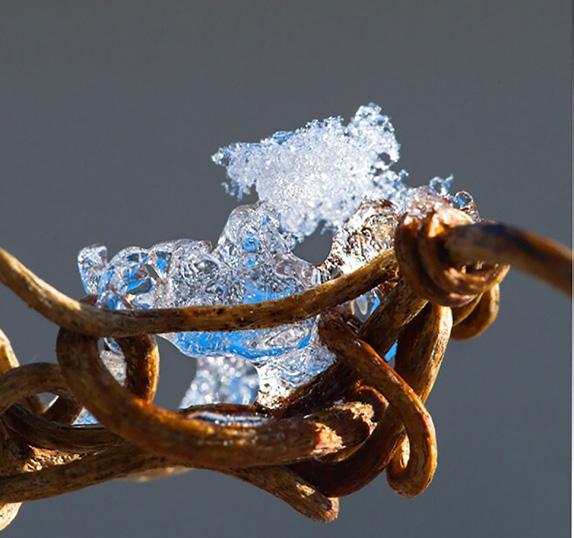
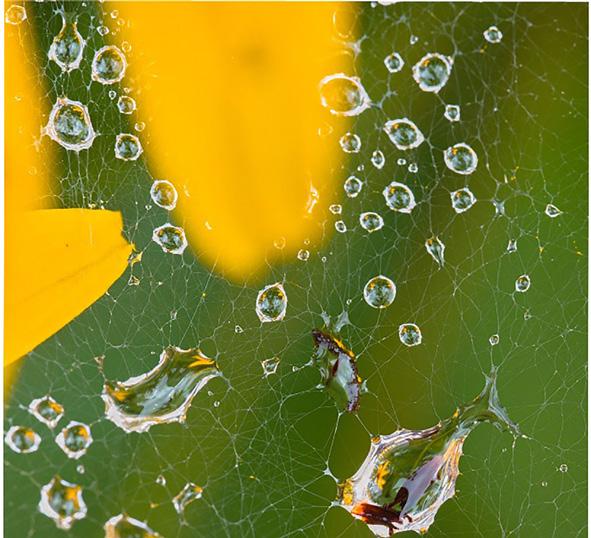
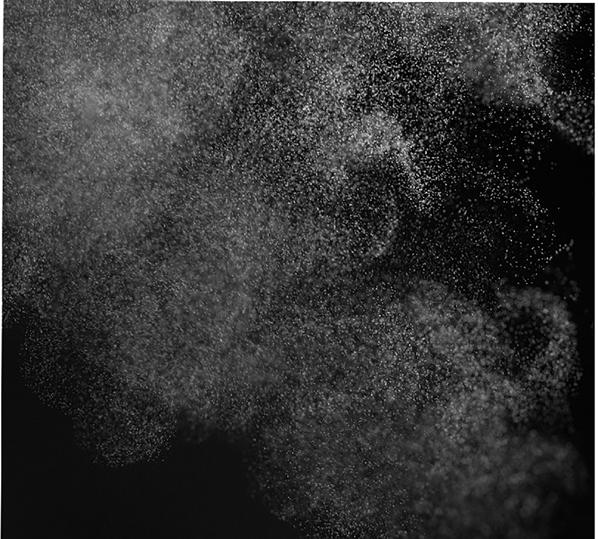
Many pioneering scientists, such as Michal Kravčík, Walter Jehne, and Anastassia Makarieva warn us that climate models are too narrowly focussed on carbon. The water cycle also plays an important role through the redistribution of heat. Where the heat is released makes a difference globally. They point out that the water cycle, particularly that part of the cycle governed by the evapotranspiration of plants, is the air conditioner of the Earth, and it is key to moderating temperatures on our planet.
Michal Kravčík is a Slovakian hydrologist who co-authored The New Water Paradigm-Water for the Recovery of Climate in 2007. Walter Jehne is an Australian climate scientist and microbiologist, founder of Regenerate
Australia. He teaches the role of the hydrological cycle to create the soil carbon sponge, sequestering water and carbon in soil and plants to mitigate the effects of climate change. Anastassia Makarieva, a Russian atmospheric physicist, is the co-developer of the biotic pump theory which is receiving increasing attention in the scientific community . This theory explains how the evapotranspiration of forests actually pulls moist air from the oceans and recirculates water through rainfall inland, underscoring how deforestation will cause vast inland areas to become deserts if we disrupt these cycles. These three scientists were some of the early voices insisting on the importance of natural ecosystems to regulate the water cycle and therefore climate. Although they each have different approaches, they all agree that mitigating the most disruptive effects of climate change must include regulating the water cycle through the restoration of natural ecosystems.
Green Water Cools
It matters where heat is transformed from sensible heat to latent heat. When evapotranspiration moves water vapour to the higher levels of the atmosphere, it takes heat with it, cooling the Earth’s surface. In turn, the surface absorbs energy from the Sun and radiates it as sensible heat, warming the air further.
A law in physics, called the Stefan-Boltzmann law, states that the amount of solar energy radiated from a surface equals the temperature of the surface raised to the fourth power (Temperature x Temperature x Temperature x Temperature). This is behind the principle of thermal mass. A lot of heat is absorbed into a dark mass such as bare soil, concrete or asphalt. The surface temperature will be much higher than the temperature registered on a more reflective surface. If we use this law to calculate the amount of heat rising into the air, the amount be will much more than if the heat had first been absorbed by a plant and used to convert water vapour and then transported into the higher atmosphere, which is much colder.
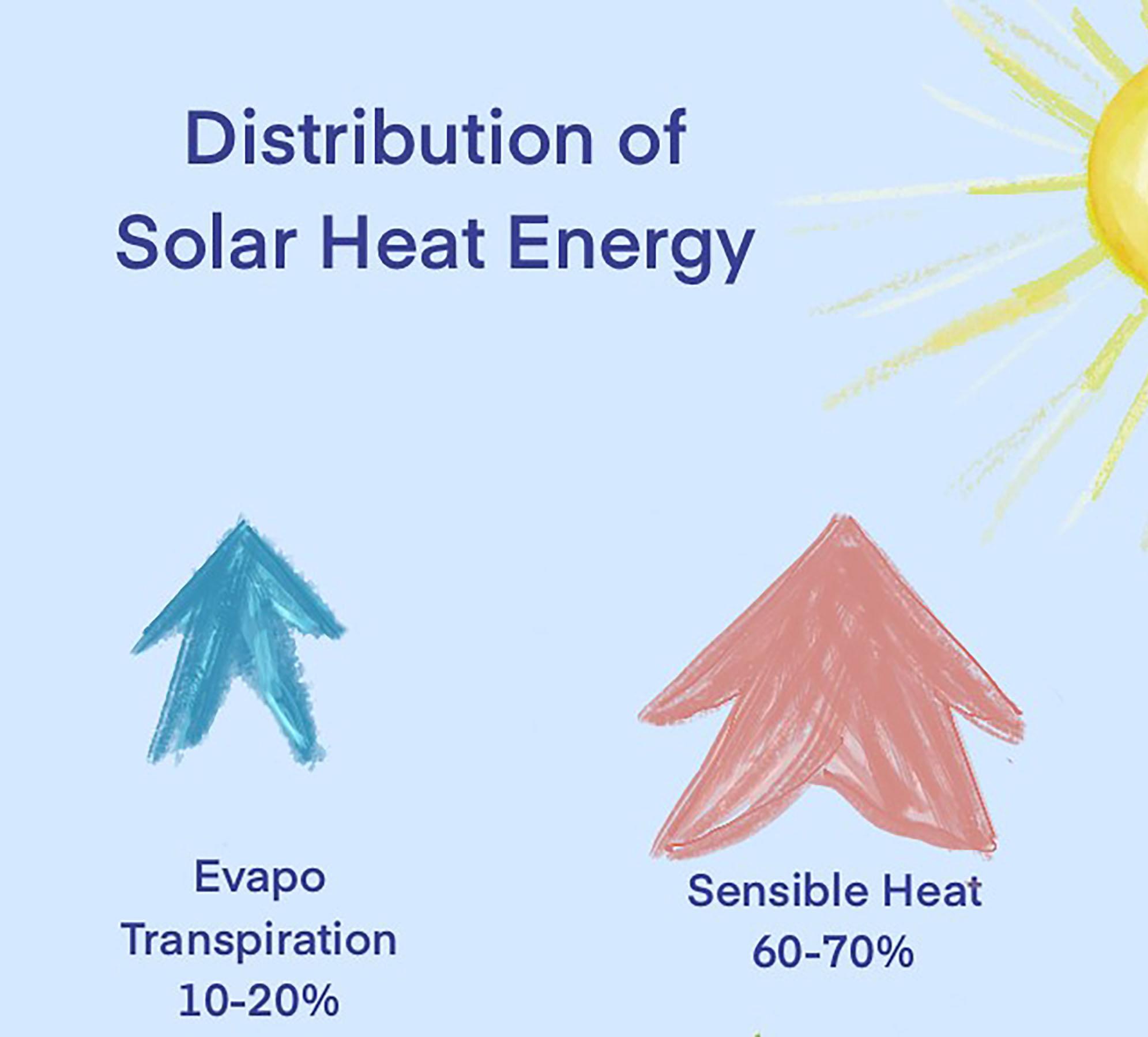
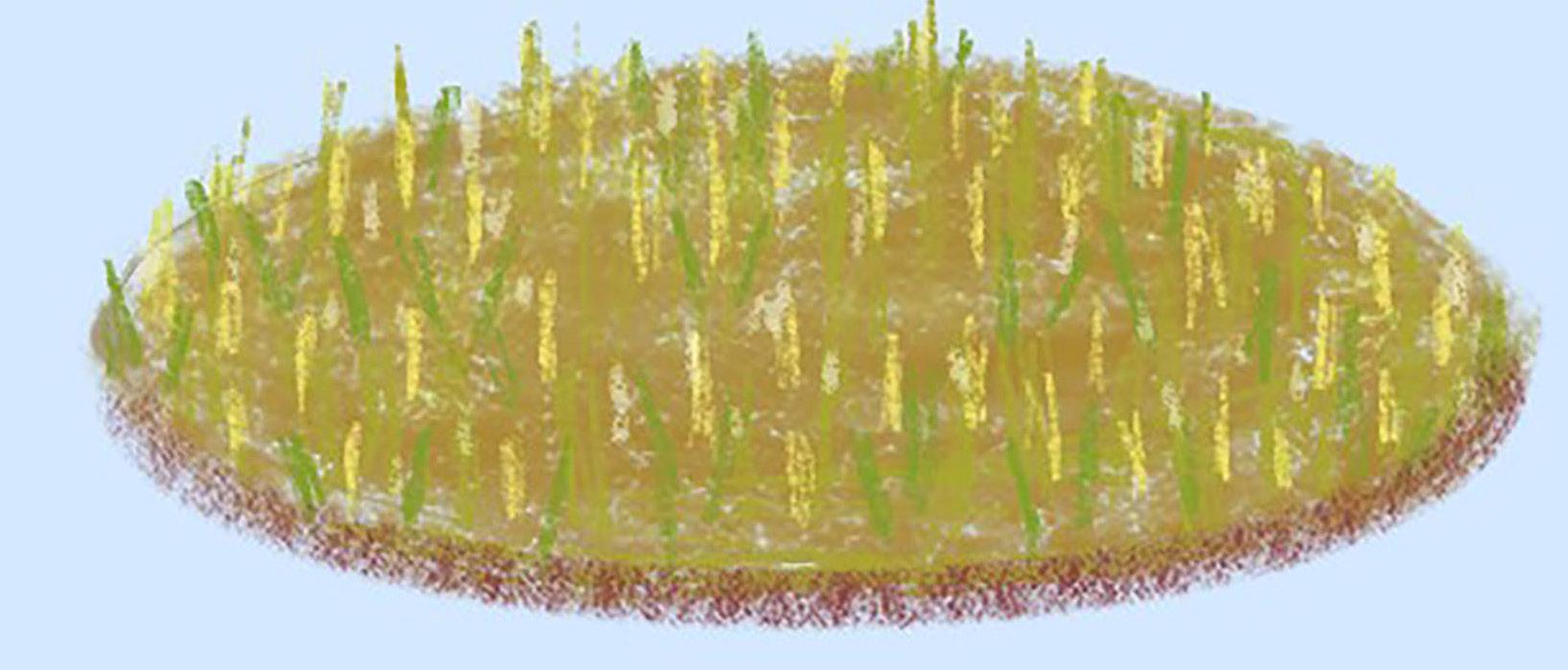
This data from Michal Kravčík of People + Water, shows how the same amount of solar energy can be distributed very differently, affecting surface temperatures depending on how much water and vegetation are in the landscape.


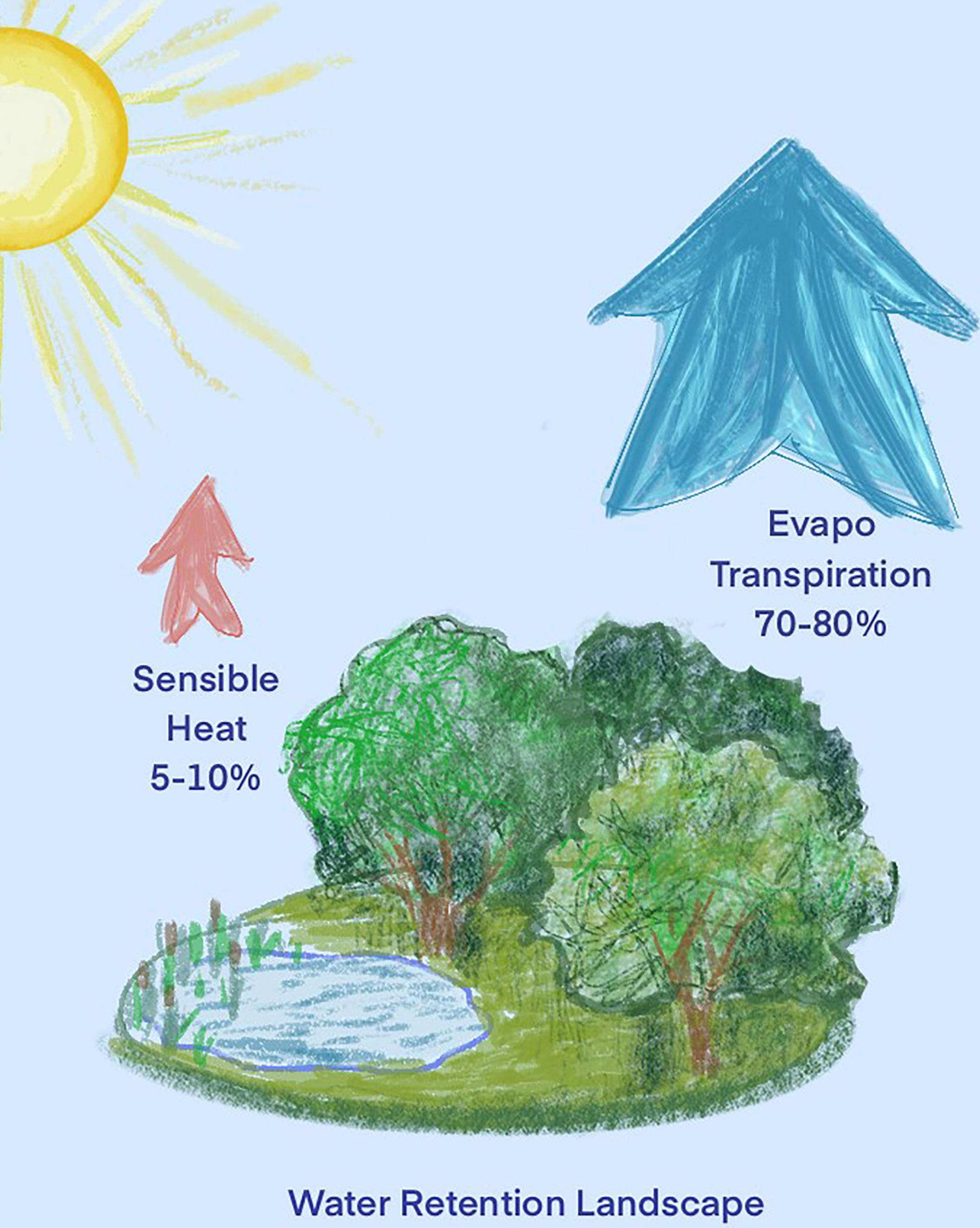
With water in the ground, more evapotranspiration from plants reduces surface temperatures. Much of the heat energy rises into the air through evapotranspiration.
When you fly in an airplane, the air outside the plane is very cold. The higher you fly, the colder it gets. This is because tiny particles in the air contain heat, and the closer you are to the Earth’s surface, the denser these particles are. Greenhouse gasses are also contained in these particles, and there are fewer of them in the upper atmosphere because the air is thinner. This means that when latent heat is released by water vapour condensing in the upper atmosphere, the higher up it is the more chance there is some of the heat will escape into space rather than be trapped by greenhouse gasses.
Michal Kravčík calls this an energy equation. If the Sun’s energy evaporates water, it will move the heat upwards, away from the surface. But if it strikes a dark mass at ground level, it will be absorbed and radiated as heat into the air. He compares this to a pot of water on the stove. As long as there is water in the pot, it boils at a constant temperature. But if you forget to turn off the burner, the boiling water eventually evaporates and your pot will get even hotter until it burns. The same is true of dehydrated landscapes; they become islands of heat. Getting water back into the soil is like turning down the burner under the pot.
Evapotranspiration enables cloud formation. Clouds form over vegetated landscapes, particularly forests where the evapotranspiration of trees transforms a great volume of water from the ground into vapour. Trees also release aerosols, such as terpenes, which cause the water vapour to coalesce into clouds.
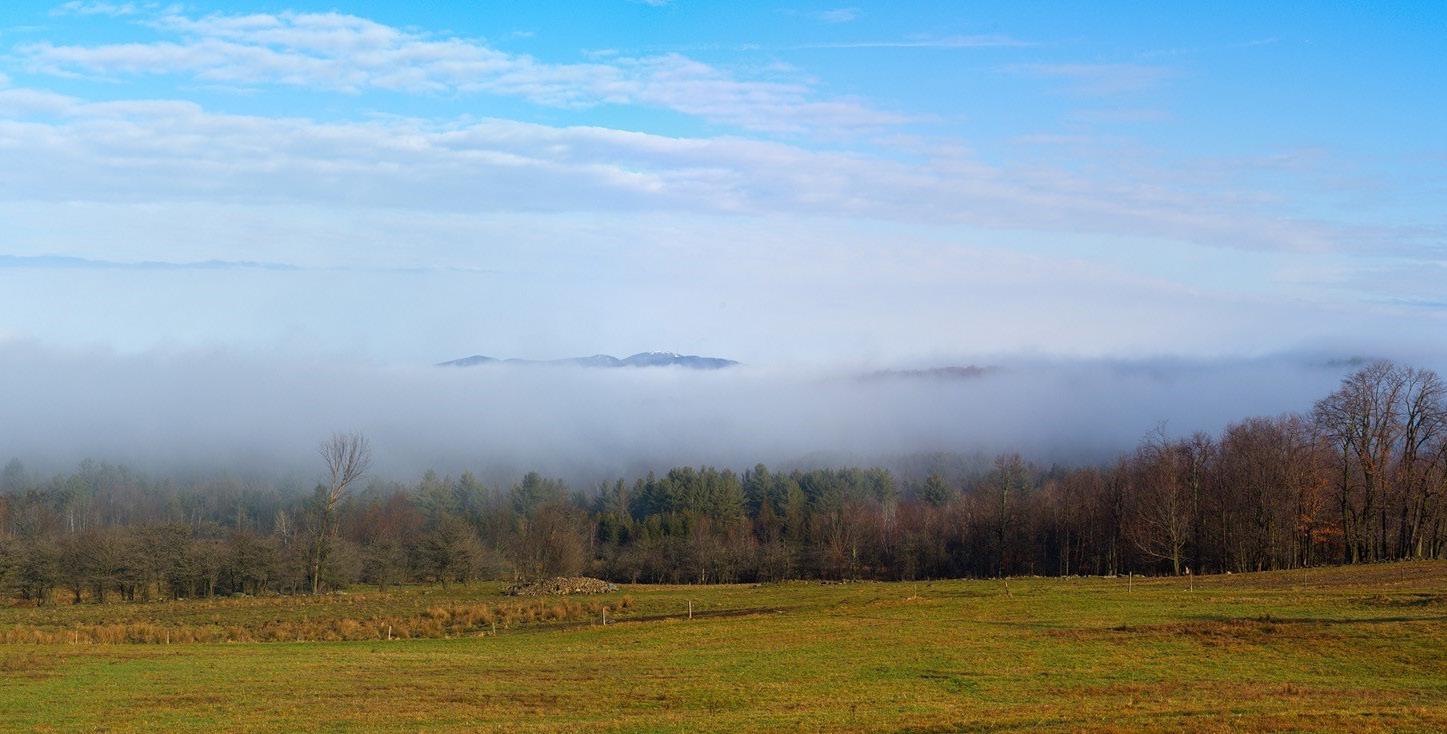
The vapour coalesces around particles in the air, and the type of particle determines the size of the droplet. Not only terpenes, but fungal and bacterial particles also act as cloud condensation nuclei (CCN). Clouds reflect the Sun’s heat away from the Earth’s surface. However, if water vapour coalesces around other types of particles, such as pollutants, they form tiny microdroplets, which create haze. Unlike clouds, hazes do not reflect sunlight back into space, rather they absorb the heat, keeping it close to the Earth’s surface. So, depending on the size of water vapour particles and where they appear, they can either remove heat from the earth or trap it.
Biology Creates Rain
Clouds are required for rain, but they don’t guarantee rain. First, enough moisture has to accumulate in the air to reach a critical threshold. Second, a catalyst is needed to precipitate the formation of raindrops. Dr Cindy E. Morris is a plant science researcher who has spent years studying how microbial ecology affects weather. She says that biology creates rain. Bacteria and fungi released from plant leaves or from the soil rise in the air and act as catalysts, triggering rainfall. We mistakenly think that temperature alone causes water to change phase from gas to liquid or from liquid to ice, but actually these plant-generated microbes are necessary to facilitate the change more readily. Although some inorganic molecules can also serve as catalysts, organic ones are far more efficient.
In temperate regions, ice crystals in the upper atmosphere are needed to set off rainfall. We think that the natural freezing point of water is 0 degrees Celsius (32 degrees Fahrenheit), but Dr Morris has shown that without a bacterial catalyst, water will not reliably form ice crystals until the temperature drops to -40 degrees Celsius. These tiny biological catalysts are carried through the air by winds. Dr Morris has charted the pathways that wind travels during different seasons to see where these little travellers may end up triggering rain. Depending on the pathway of the wind, there may or may not be enough catalysts to produce rain on a given day. So even
in an area lying at a great distance from a forest, wind is required to bring in the organic molecules to stimulate rainfall. The more of these biological catalysts from vegetation are in the air, the more frequently and gently it rains.
A strange phenomenon was noted in south western Australia at the turn of the 20th Century. A large area of land was cleared for agriculture, but the wild rabbits so prevalent in the Australian bushland devastated the crops. So, between 1901 and 1907, the state built a 3,200-kilometre fence to keep the rabbits out. The result was a clear, the “bunny fence”, as it was called, created a clear, long demarcation between the native vegetation and agricultural land. Curiously, over the agricultural land the sky is usually clear, while over native vegetation there is significant cloud cover. Consequently, the land covered by native vegetation receives more rain than the agricultural land. Nothing, aside from land use, could account for the difference in climate and scientists have been puzzled by this phenomenon for many years. There are numerous hypotheses. Dr Morris’ hypothesis has yet to be definitively proven, but there is clearly a connection between native vegetation and the presence of clouds and rain, and the disruption caused by modern agricultural practices.
When it rains, some of the water flows over the ground, always downward along slopes, gathering into streams and rivers which carry it to the sea, and some of it penetrates the land. The rain hydrates the soils, nourishes the vegetation and refills the aquifers. The more rainwater that soaks into the land, the better it is for the land, animals and people.
Eventually enough water will filter into the land and hit an impenetrable surface such as bedrock. Here it begins to accumulate underground and pressure builds up. It is this pressure that forces natural springs to come up from the earth. Underground water keeps wells filled, keeps streams and wetlands from drying up in the heat of summer. Underground water keeps the plants alive and permits evapotranspiration, which moves the heat away from the Earth’s surface.
Unfortunately, human activity has reduced the amount of underground water stored in most parts of the Earth. Not only does a growing population
continue to dig wells and draw on water reserves, but also poor water management reduces the amount of rainfall which gets back into the earth to refill the reserves. Agricultural soils left bare and tilled with heavy machinery compact the soils, preventing deep infiltration of rainwater. Dry bare soil becomes hydrophobic, repelling rainwater and causing it to run off, carrying topsoil into waterways. Hard-packed impermeable surfaces typical of cities, such as roads and industrial areas, collect massive amounts of rainwater, diverting it into storm water infrastructures. Humanity expedites the release of freshwater into the oceans and suffers the consequences of the resulting dehydration.
Floods are a symptom of this cycle of dehydration. Excess water drains off the land quickly with sudden heavy rainfall. Compacted soils can’t percolate, and human infrastructure is designed to evacuate the water as quickly as possible. Drought conditions bake the land, and wildfires cook the soil making it even less permeable, making it difficult for the land to absorb rain. Torrential rains carry away the remaining organic matter, washing whatever fertility is left into the waterways. Until we improve water infiltration across our landscapes, this vicious cycle of drought and floods will continue to deplete our water resources and drain fertility from our soils.
Biodiversity: Cascades of life
In our story of the restoration of the Loess Plateau desert, we saw that as soon as carbon and water get together, life emerges. The activity begins with microbes, gradually becoming more diverse until it forms a complex ecosystem, a cascade of life. It begins with the smallest life forms, the first to feed on carbon and water: the microorganisms.
The existence of microorganisms was discovered in the 1600’s with the invention of the microscope. It wasn’t until the 1800’s that pathogens were discovered as the cause of disease, which led to the development of pathogenkilling antibiotics derived from moulds.
But it was only in the 1980’s that scientists discovered the incredible prevalence of microorganisms everywhere. Before that, microbiologists had to grow microorganisms in a laboratory to identify and study them. With the advent of computer technology and the ability to read DNA, microbiologists were able to identify thousands of species in the environment, even if they couldn’t isolate them or understand what they did. From samples of soil, water or living tissue, they analysed the DNA of the coexisting species, coming finally to astounding conclusion which is slowly revolutionising medicine, agriculture and ecology: all life is made up of complex communities of microorganisms!
When we examine the DNA of a human being, we find that only 10% of the cells in our body are human cells; the other 90% are microbial. Our bodies are colonised by microbes at the moment of birth, as we pass through the birth canal in our mother’s body. The atmosphere, the food we eat adds more microbes to the community of our microbiome. Most of these microorganisms are beneficial. We need to rid ourselves of the idea that microbes are pathogens that should be killed off. A sterile environment is, in fact, the perfect environment for colonisation by pathogens, because it is unprotected. Our best protection against infection is a thriving population of beneficial microbes well established inside our body and out.
The same is true for all living things. Plants and animals all have unique microbiomes colonizing their bodies. The health of microbial communities determines the health of their hosts and their hosts’ environment.
Microbes are very specialised in terms of what they do and where they live. That is why there are so many species. There are species specialised for every environment and substance on Earth. The life cycle of a microbe is short. But with the right food, right temperature, right pH balance, right humidity, they eat and reproduce at a furious rate. Their metabolism produces waste materials rapidly and releases them into their environment. These waste materials become the food for other species. But as soon as conditions change - the food runs out or the temperature varies - they stop
their activity, they go dormant or die. Because the metabolites produced by a microorganism are useful to some other organism, they alter the balance of the environment, giving space to another species to grow and multiply. So, the short life of a microorganism plays a pivotal role in the succession of life.
The life of compost is a case in point. Made up of layers of waste, it ideally needs a good ratio between carbon and nitrogen. Kitchen waste is high in nitrogen, so adding a layer of dried straw or leaves rich in carbon will ensure a healthy balance. Every element you add to that compost is home to a unique microbiome, from the vegetable peels to the straw. With the warm, moist conditions in the compost pile, the microbes go to work, decomposing their favourite food. As the food in the compost pile breaks down, nutrients are released. The compost pile heats up. The next group of decomposer microbes, the thermophilic or heat loving microbes, becomes active. There are many of these, each one specialised to consume different nutrients. Conditions in the pile continue to change as other groups of microbes take over from the previous group, which goes dormant or dies.
Make a compost
There are many ways to make compost. You can buy a commercial composter or simply make one in a bin in the backyard. The most important thing is to get a balance of dried woody material and food waste or manure. There needs to be more dry stuff than wet, otherwise it will smell bad. Every time you add food scraps, cover them with some of your dry material. This could be straw, dried grass, dead leaves or wood chips. Then watch your compost
evolve! It will get warm, then cool, and the bits of food will break down. Keep it covered so it doesn’t dry out. If it gets too dry, add some water. It should stay moist but not sodden. Once it has cooled, you will notice worms and little insects moving in for the finishing touches.
A compost is a masterpiece of nature’s closed loop cycle. From within six months to a year, your compost will be a rich brown pile of earth, which you can use to feed your houseplants or your garden.
After the thermophilic phase is over, the compost pile matures at a slower rate. The mesophilic microorganisms take over, ones who thrive in more moderate temperatures, between 20-45 degrees centigrade. In the last stages of the composting, worms, insects and fungi move in to complete the process. The final result is a rich soil amendment, full of nutrients, organic acids and molecules which stimulate plant growth. This miraculous transformation has been accomplished by hundreds of thousands of microbial species each taking a turn in one stage of the process. At each stage, the conditions created by the group of microbes at work change the environment and signal the next set of workers to take over. We call this process a trophic cascade.
Tropic cascades are typical in all ecological systems. Different species interact when the environment produces conditions which are favourable for them. Their interactions produce results which alter the environment and then other species come into dominance. The more an ecosystem matures, the more species diversity grows. More complex interactions between multiple species creates a richer and more resilient ecosystem. Remove any one species and another will take over the job. But if you remove too many, leaving gaps in the ecosystem, things will break down.
Imagine moving into a new neighbourhood. At first, you don’t know anyone. Life is a bit lonely and difficult. But then you make friends and it gets easier. The longer you live there, the more connections you make. You know the best places to go, you have many friends and acquaintances. Life becomes easier, richer. A good community with many social connections makes for a good quality of life.
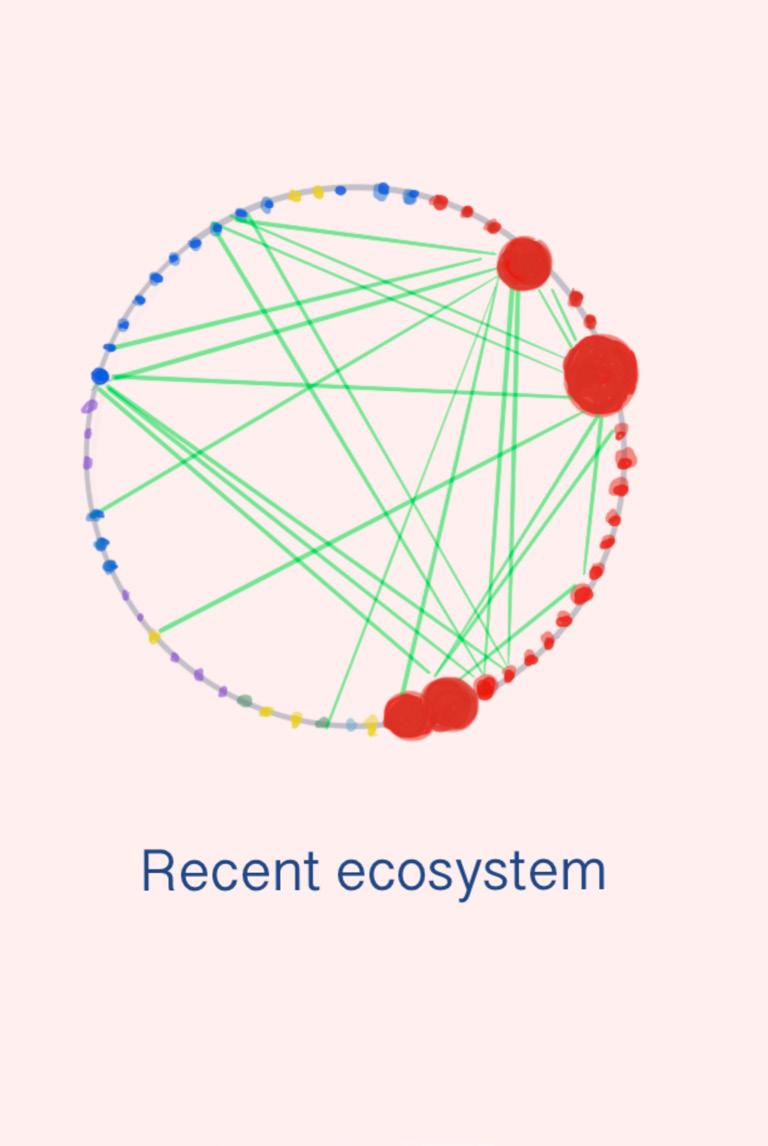
Ecosystem Connectivity :
The dots along the outside circle represent different species in the ecosystem. Different colours represent different families. Larger dots represent larger populations. The green lines are interactions between species. We can see that as an ecosystem matures, its connectivity and richness increase.
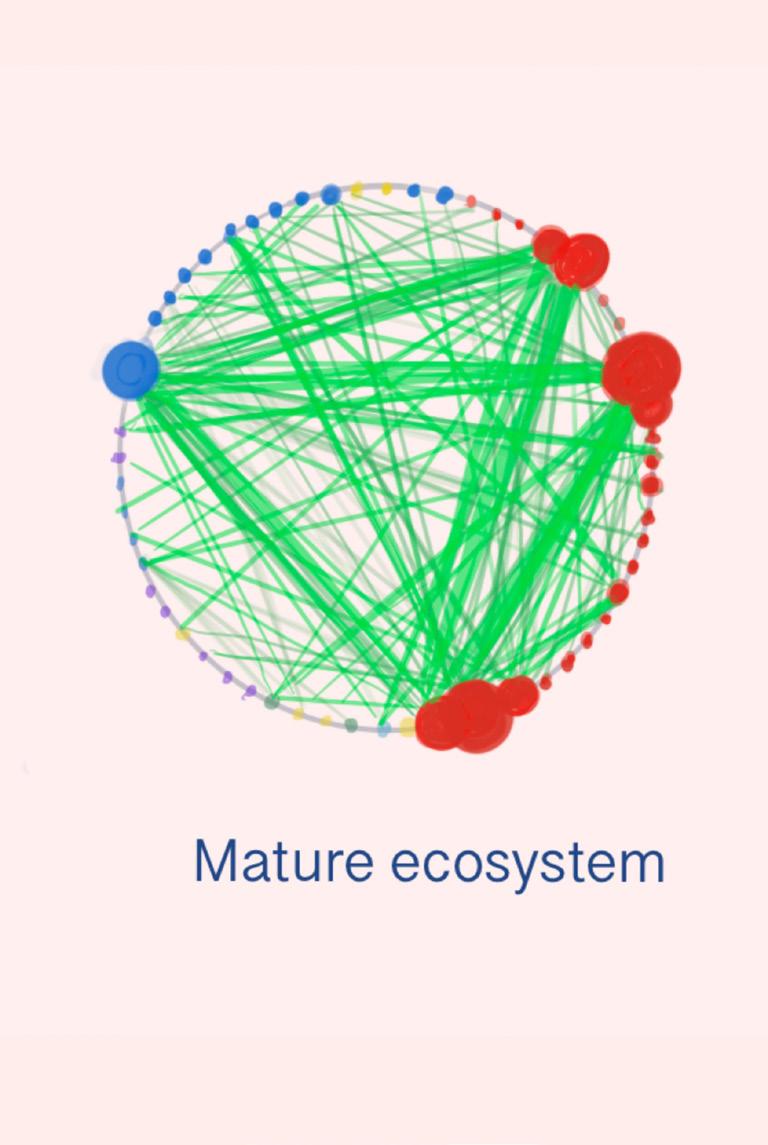
Have the group stand in a circle. Give one person a ball of yarn and ask them to hold one end of the yarn and pass the ball to another person across the circle. Have the participants pass the yarn randomly back and forth around the circle while continuing to hold their bit of yarn. After a while the whole group will be connected by an intricate web.
Explain that every connected strand is a relationship. Now the facilitator can take a pair of scissors and cut one strand at a time. The more complex the web, the longer it takes to break apart. With only a few connections, the web would be broken with only one or two cuts.
